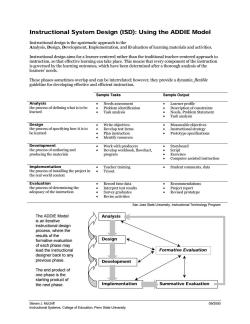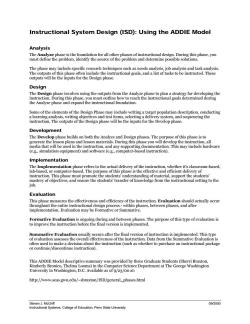华南师范大学:《教学媒体理论与实践》课程教学资源(文献资料)Instructional System Design(ISD)- Using the ADDIE Model

Instructional System Design(ISD):Using the ADDIE Model ional design is the su Analysis,Design,Development,Implementation,and Evaluation of learning materials and activities. s for a le h to Sample Tasks Sample Output ess of defining what is to be Task analysis Design Write obiecti Measurable c s of specifying how it is to Develop test items pntoctional identify resources Developmen Storyboard the program : Computer as ssisted instruction ortang Student comments,data · equacy of the ins : Revised prototype San Jose State University.Instructional Technology Prograr The ADDIE Model Analysis is an iterative instructional design where the valuatior Design of each phase may lead the instructional Formative Evaluation Development The end product of one phase is the ct o Implementation Summative Evaluation Steven J.McGriff 092000 ional Systems,Collegeof Edu cation,Penn State University
Steven J. McGriff 09/2000 Instructional Systems, College of Education, Penn State University Instructional System Design (ISD): Using the ADDIE Model Instructional design is the systematic approach to the Analysis, Design, Development, Implementation, and Evaluation of learning materials and activities. Instructional design aims for a learner-centered rather than the traditional teacher-centered approach to instruction, so that effective learning can take place. This means that every component of the instruction is governed by the learning outcomes, which have been determined after a thorough analysis of the learners’ needs. These phases sometimes overlap and can be interrelated; however, they provide a dynamic, flexible guideline for developing effective and efficient instruction. Sample Tasks Sample Output Analysis the process of defining what is to be learned · Needs assessment · Problem identification · Task analysis · Learner profile · Description of constraints · Needs, Problem Statement · Task analysis Design the process of specifying how it is to be learned · Write objectives · Develop test items · Plan instruction · Identify resources · Measurable objectives · Instructional strategy · Prototype specifications Development the process of authoring and producing the materials · Work with producers · Develop workbook, flowchart, program · Storyboard · Script · Exercises · Computer assisted instruction Implementation the process of installing the project in the real world context · Teacher training · Tryout · Student comments, data Evaluation the process of determining the adequacy of the instruction · Record time data · Interpret test results · Survey graduates · Revise activities · Recommendations · Project report · Revised prototype San Jose State University, Instructional Technology Program Analysis Design Development Implementation Summative Evaluation Formative Evaluation The ADDIE Model is an iterative instructional design process, where the results of the formative evaluation of each phase may lead the instructional designer back to any previous phase. The end product of one phase is the starting product of the next phase

Instructional System Design(ISD):Using the ADDIE Model Analysis The phase may include specific research techniques such as needs analysis,job analysis and task analysis. b the inputs for the Design phasercon nd ass tobe nsucted.mhese Design The Design phase involves using the outputs from the Analyze phase to plan a strategy for developing the ring th Some of the eler ents of the sign Phas may include egpoationkeeptionomdctng will be the inputs fo the sequencing th Development The Develop phase builds on both the Analyze and Design phases.The urpose of this phase is to During th ase you wi dwar (e.g.,simulation equipment)and software (e.g.computer-based instruction). Implementation instruction.This phase must promote the students understanding of material,sup oport the students' mo apalMouy jo ajsuen squapnis am amsua pue Evaluation This phase measures the effectiven s and efficiency of the instruction.Evaluation should actually occur een phases.The purpose of this type of evaluation is native evalu tion u s after the final version of instruction is implemented.This tyn of evaluation ass sses the overall effectiveness of the instruction.Data from the Summative Evaluation is instruc This ADDIE Model descriptive summary was provided by three Graduate Students(Sherri Braxton, 9/23/00 http://www.seas.gwu.edu/-sbraxton/ISD/general_phases.html 09/2000
Steven J. McGriff 09/2000 Instructional Systems, College of Education, Penn State University Instructional System Design (ISD): Using the ADDIE Model Analysis The Analyze phase is the foundation for all other phases of instructional design. During this phase, you must define the problem, identify the source of the problem and determine possible solutions. The phase may include specific research techniques such as needs analysis, job analysis and task analysis. The outputs of this phase often include the instructional goals, and a list of tasks to be instructed. These outputs will be the inputs for the Design phase. Design The Design phase involves using the outputs from the Analyze phase to plan a strategy for developing the instruction. During this phase, you must outline how to reach the instructional goals determined during the Analyze phase and expand the instructional foundation. Some of the elements of the Design Phase may include writing a target population description, conducting a learning analysis, writing objectives and test items, selecting a delivery system, and sequencing the instruction. The outputs of the Design phase will be the inputs for the Develop phase. Development The Develop phase builds on both the Analyze and Design phases. The purpose of this phase is to generate the lesson plans and lesson materials. During this phase you will develop the instruction, all media that will be used in the instruction, and any supporting documentation. This may include hardware (e.g., simulation equipment) and software (e.g., computer-based instruction). Implementation The Implementation phase refers to the actual delivery of the instruction, whether it's classroom-based, lab-based, or computer-based. The purpose of this phase is the effective and efficient delivery of instruction. This phase must promote the students' understanding of material, support the students' mastery of objectives, and ensure the students' transfer of knowledge from the instructional setting to the job. Evaluation This phase measures the effectiveness and efficiency of the instruction. Evaluation should actually occur throughout the entire instructional design process - within phases, between phases, and after implementation. Evaluation may be Formative or Summative. Formative Evaluation is ongoing during and between phases. The purpose of this type of evaluation is to improve the instruction before the final version is implemented. Summative Evaluation usually occurs after the final version of instruction is implemented. This type of evaluation assesses the overall effectiveness of the instruction. Data from the Summative Evaluation is often used to make a decision about the instruction (such as whether to purchase an instructional package or continue/discontinue instruction). This ADDIE Model descriptive summary was provided by three Graduate Students (Sherri Braxton, Kimberly Bronico, Thelma Looms) in the Computer Science Department at The George Washington University in Washington, D.C. Available as of 9/23/00 at: http://www.seas.gwu.edu/~sbraxton/ISD/general_phases.html
按次数下载不扣除下载券;
注册用户24小时内重复下载只扣除一次;
顺序:VIP每日次数-->可用次数-->下载券;
- 华南师范大学:《教学媒体理论与实践》课程教学资源(文献资料)An Instructional System for Computer And Information Literacy.pdf
- 华南师范大学:《教学媒体理论与实践》课程教学资源(文献资料)Effectiveness of cooperative learning - WebQuest as a tool to produce scientific videos.pdf
- 华南师范大学:《教学媒体理论与实践》课程教学资源(文献资料)COOPERATIVE LEARNING - THEORY, PRINCIPLES, AND TECHNIQUES.pdf
- 华南师范大学:《教学媒体理论与实践》课程教学资源(文献资料)单元专业词汇 Professional Vocabulary.doc
- 华南师范大学:《教学媒体理论与实践》课程教学资源(参考书籍)Understanding 21st Century Learners.pdf
- 华南师范大学:《教学媒体理论与实践》课程教学资源(文献资料)Cooperative Learning and Object-Orientated Development Methods.pdf
- 华南师范大学:《教学媒体理论与实践》课程教学资源(参考书籍)Achieving 21st Century Learning Environments.pdf
- 华南师范大学:《教学媒体理论与实践》课程教学资源(PPT课件)UNIT2 教学系统 Instructional system.pptx
- 华南师范大学:《教学媒体理论与实践》课程教学资源(文献资料)How Does Technology Influence Student Learning.pdf
- 华南师范大学:《教学媒体理论与实践》课程教学资源(文献资料)UNIT1 技术、媒体与学习(单元专业词汇 Professional Vocabulary).doc
- 华南师范大学:《教学媒体理论与实践》课程教学资源(文献资料)A Tool for Measuring Active Learning in the Classroom.pdf
- 华南师范大学:《教学媒体理论与实践》课程教学资源(文献资料)21st Century Learning Environments.pdf
- 华南师范大学:《教学媒体理论与实践》课程教学资源(文献资料)Using Active Learning in the Classroom.pdf
- 华南师范大学:《教学媒体理论与实践》课程教学资源(参考书籍)UNIT1 技术、媒体与学习.pdf
- 华南师范大学:《教学媒体理论与实践》课程教学资源(PPT课件)UNIT1 技术、媒体与学习.pptx
- 华南师范大学:《教学媒体理论与实践》课程教学资源(PPT课件)课程介绍(主讲:穆肃).pptx
- 北方工业大学:电子信息工程专业《心理健康与职业发展》课程教学大纲.pdf
- 北方工业大学:电子信息工程专业《大学美育》课程教学大纲.pdf
- 广东茂名农林科技职业学院:2021年各专业人才培养方案(汇编).pdf
- 南京农业大学:《毕业实习与毕业论文》课程教学大纲 Undergraduate Internship and Thesis Writing.pdf
- 华南师范大学:《教学媒体理论与实践》课程教学资源(文献资料)Learning from web-based instructional systems and cognitive style.pdf
- 华南师范大学:《教学媒体理论与实践》课程教学资源(PPT课件)UNIT3 ASSURE模式 The ASSURE Model.pptx
- 华南师范大学:《教学媒体理论与实践》课程教学资源(参考书籍)Integrating Technology and Media into Instruction The ASSURE Model.pdf
- 华南师范大学:《教学媒体理论与实践》课程教学资源(文献资料)《Four Seasons》教学设计方案.pdf
- 华南师范大学:《教学媒体理论与实践》课程教学资源(文献资料)平抛物体的运动——教学设计方案.pdf
- 华南师范大学:《教学媒体理论与实践》课程教学资源(文献资料)小学语文课教学中ASSURE模型的应用(一).pdf
- 华南师范大学:《教学媒体理论与实践》课程教学资源(文献资料)小学语文课教学中ASSURE模型的应用(二).pdf
- 华南师范大学:《教学媒体理论与实践》课程教学资源(文献资料)英语课教学中ASSURE模型的应用.pdf
- 华南师范大学:《教学媒体理论与实践》课程教学资源(文献资料)语文课教学中ASSURE模型的应用初中语文:《湖心亭看雪》.pdf
- 华南师范大学:《教学媒体理论与实践》课程教学资源(文献资料)科学与技术类课程中ASSURE模式的应用.pdf
- 华南师范大学:《教学媒体理论与实践》课程教学资源(文献资料)信息与技术课中ASSURE模式的应用.pdf
- 华南师范大学:《教学媒体理论与实践》课程教学资源(文献资料)历史课教学中ASSURE模型的应用.pdf
- 广东财经大学:创业教育学院《多媒体技术与应用》课程教学大纲.doc
- 广东财经大学:创业教育学院《会计学》课程教学大纲.doc
- 广东财经大学:创业教育学院《商务素养与商务谈判训练》课程教学大纲.doc
- 广东财经大学:创业教育学院《主要国家概况(英)》课程教学大纲.docx
- 广东财经大学:创业教育学院《数据模型与决策课程》课程教学大纲.doc
- 广东财经大学:创业教育学院《金融学》课程教学大纲.doc
- 广东财经大学:创业教育学院《管理学》课程教学大纲.doc
- 广东财经大学:创业教育学院《员工招聘与测评》课程教学大纲.docx
